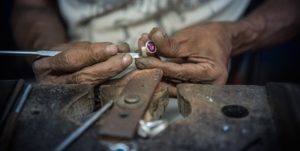 October 18th is Anti-Modern Slavery Day. This annual reminder gives businesses the opportunity to reflect on how their supply chains may be impacted by modern slavery and what steps they can take to eliminate it.
October 18th is Anti-Modern Slavery Day. This annual reminder gives businesses the opportunity to reflect on how their supply chains may be impacted by modern slavery and what steps they can take to eliminate it.
Modern slavery is labor that is done unwillingly or provides an individual with no viable alternatives, making it impossible for them to leave their work. There are multiple kinds of modern slavery, including forced labor, child labor, and debt bondage, and today there are an estimated 40.3 million people trapped in modern slavery.
The unfortunate truth is that modern slavery is found in supply chains around the world, even if this is hidden from consumers or even the companies making these products. Here are a few steps businesses can take to combat modern slavery in their supply chains and eliminate it once and for all:
-
Define the goal
The first step is to clearly define what specific actions your business wants to take to combat modern slavery. Referring to corporate social responsibility initiatives is a good way to determine the objectives and timelines your business has committed to on a global scale—for example, ensuring 100% of immediate suppliers comply with social certification requirements by 2023. You can also choose to address raw materials that are known to be linked to forced labor, such as cocoa, palm oil, cotton, or conflict minerals. Read our previous blog to learn more about determining where to start.
-
Assess the status quo
Once the goal has been defined, it is time to see where things currently stand. Making improvements to your supply chain first requires knowing who is involved in your supply chain. Businesses can assess the status quo by identifying their suppliers—who they are and who they work with—as well as where they are located. Location can be a helpful indicator of modern slavery: for example, there is a high likelihood of forced labor occurring in Turkmenistan or Uzbekistan.
It can be tempting to try to assess the status quo for the entire supply chain (tier 1 and below), and attempt to map suppliers down to the source. However, for many businesses achieving this objective of end-to-end visibility requires significant time and resources that may distract from the immediate goal as defined in step 1. Instead, it is better to address supply chain mapping in phases to ensure your business takes concrete, consistent action against modern slavery in a reasonable timeframe. After tier 1 is addressed, tier 2 can come next.
Once you get a sense of the status quo and identify the necessary suppliers, you can then begin collecting data.
-
Collect critical data and take action
 To ensure your business collects the right data to meet your anti-modern slavery objectives, it is important to determine what data you need from suppliers to assess whether modern slavery is involved in your supply chains. Helpful data can include social certifications, audits, or regular surveys to gather more detailed information on supplier facility practices. Businesses should also determine how often this information must be collected from suppliers, how often updates are needed, the deadline to respond to your request, how noncompliant suppliers will be addressed, and the consequences of noncompliance.
To ensure your business collects the right data to meet your anti-modern slavery objectives, it is important to determine what data you need from suppliers to assess whether modern slavery is involved in your supply chains. Helpful data can include social certifications, audits, or regular surveys to gather more detailed information on supplier facility practices. Businesses should also determine how often this information must be collected from suppliers, how often updates are needed, the deadline to respond to your request, how noncompliant suppliers will be addressed, and the consequences of noncompliance.
In addition, it may not be necessary to collect data from all suppliers across the supply chain. Depending on your business objectives, it may only be necessary to target your immediate suppliers, suppliers in certain countries, and/or only suppliers of certain materials.
Once your business has collected the required data and documentation from the relevant suppliers, you will have a clearer picture of which of your supply chain partners do not meet anti-modern slavery requirements. Follow up actions can then be taken, such as working with your existing suppliers to develop a remediation plan or finding new suppliers altogether.
-
Monitor your supply chains and take it a step further
Finally, once your business has made the necessary changes to your supply chain to ensure improved social responsibility, you must monitor your supply chains to ensure continued compliance. The Transparency-One platform facilitates this process by alerting you when certifications are about to expire and providing live, detailed reports on supplier compliance with business requirements.
When the time is right, businesses can also take it a step further by expanding on their initial objectives. Maybe now is the time to collect information from Tier 2+ suppliers or expand the anti-modern slavery requirement to other countries and/or raw materials. Businesses can also choose to publicize their progress and communicate the action they have taken to combat modern slavery with their consumers. By using the supply chain data already collected, you can develop marketing campaigns to showcase the progress you have made, setting a positive example for the industry.
 Transparency-One can help businesses at every step in the fight against modern slavery, from setting objectives to collecting supplier data to developing consumer engagement campaigns. The Transparency-One solution can identify suppliers at multiple levels, send and set up requirements, and provide real-time analytics for supplier compliance and potential supply chain risk. Our team can then work with you to use this data to engage with consumers for stronger consumer trust.
Transparency-One can help businesses at every step in the fight against modern slavery, from setting objectives to collecting supplier data to developing consumer engagement campaigns. The Transparency-One solution can identify suppliers at multiple levels, send and set up requirements, and provide real-time analytics for supplier compliance and potential supply chain risk. Our team can then work with you to use this data to engage with consumers for stronger consumer trust.
Businesses cannot eliminate modern slavery in their supply chains overnight. The process is lengthy, rigorous, and requires diligence and patience. However, if businesses take the opportunity every year to assess their current status and identify ways to continue their progress, the industry will make significant progress towards a world free of modern slavery.









